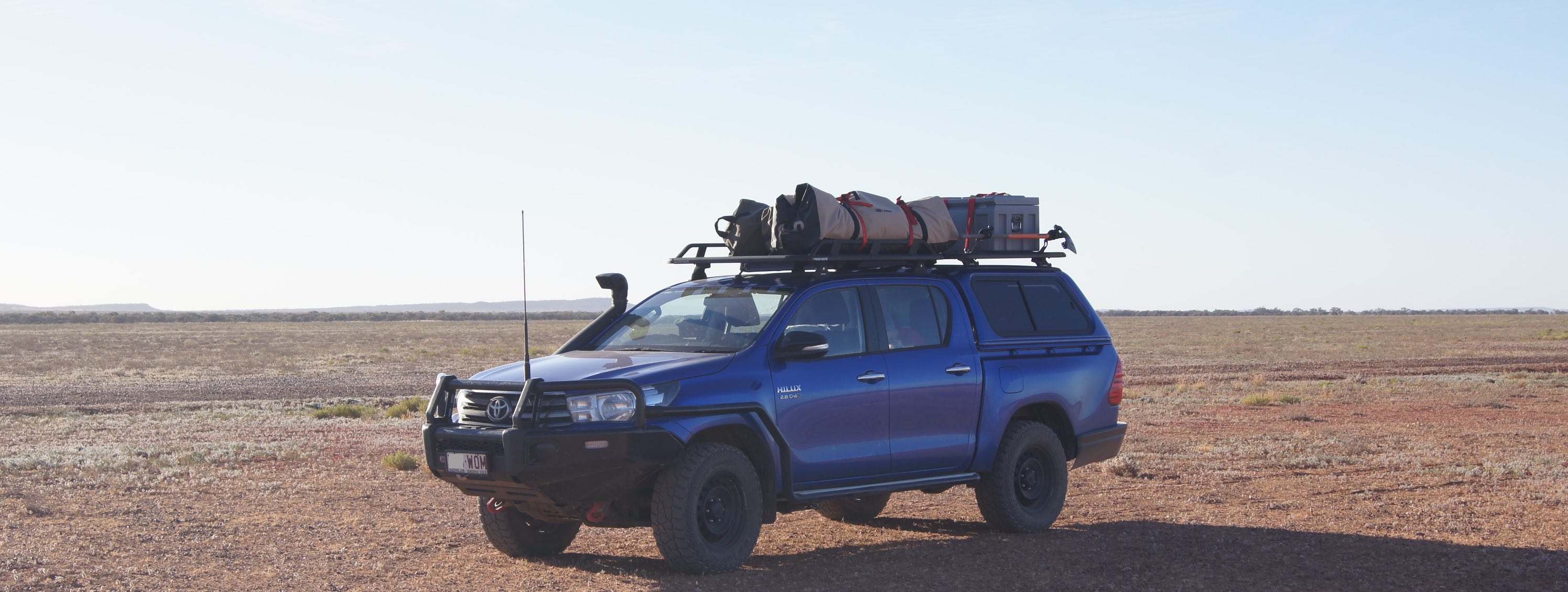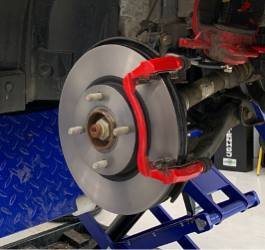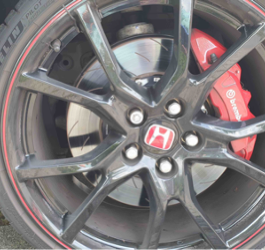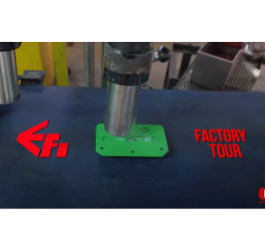Best Brake Upgrades for your Ute or 4x4

Quick Links
Whether you plan on using your Ute or 4x4 for overlanding, towing or as a daily driver, upgrading your brake pads & rotors is a cost-effective way to increase braking performance and improve vehicle safety. Having a robust brake setup that you can depend on is also vital if you plan on loading your vehicle up to its gross weight limit or find yourself driving down a long hill descent.
In this article, we’ll recommend suitable braking products from the EBC range and equip you with everything you need to know to ensure your truck or 4x4 has a heavy-duty brake system that’s ready for whatever task lies ahead.

Why Fit Upgraded Brakes to Your Truck or 4x4?
Your vehicles brake system can be thought of as a system that converts one type of energy (kinetic energy) into another (heat). The formula for kinetic energy states that KE is proportional to vehicle mass multiplied by velocity squared.

Whilst it seems intuitive that a vehicle braking from a higher top speed will exert increased load on the brake system, and you’d be correct, the effect of increased airflow at higher speeds shouldn’t be underestimated as this airflow significantly increases the rotors’ ability to cool off between consecutive stops. If you hooked up a thermocouple to measure brake rotor temperature on a racing car you’d see large fluctuations in rotor temperature around the lap, with the brakes being coolest at the end of the longest straight and hottest at the end of the most severe braking zone. Utes & 4x4’s however pose a very different challenge for the brake system and this is characterised by their high mass and low speed.
Unless you’re building a trophy truck for the Baja 1000, chances are you’ll rarely exceed 110 km/h in your Ute or 4x4. Since kinetic energy is proportional to the square of velocity, you’d be forgiven for thinking modest vehicle speeds won’t be enough to make your brake system sweat. However, the key aspect to consider here is the reduced airflow and thus reduced brake cooling at moderate vehicle speeds. If we hooked up a thermocouple to measure brake rotor temp on a 4x4 when being driven off-road, we’d see a much more gradual increase in rotor temperature (vs. a racing car) however there would be minimal fall in temperature between successive stops because the reduced airflow diminishes the brake rotor’s ability to cool. The result is that Ute and 4x4 brake rotor temps steadily, but relentlessly, climb over time as more and more energy gets dumped into the brake rotor but is slow to be dissipated into the surrounding air. If your brake pads can’t handle the extra heat, you’ll begin to experience a drop in braking performance known as brake fade.
Before we explore ways to avoid brake fade, there’s also a couple other factors to be aware of that contribute to higher brake temperatures in Utes and 4x4’s. The first challenge is for vehicles running steel wheels, which shroud the brake rotor and substantially reduce airflow and thus brake cooling when compared to alloy wheels with a more open spoke profile. Another issue is many Utes & 4x4’s run comparatively small diameter rims which limits the maximum diameter of the brake rotor. When you combine a small diameter brake rotor, with a small surface area, with minimal cooling airflow and a heavily laden vehicle, the braking energy is concentrated into a small volume and this predictably results in high brake system temperatures. Vehicles fitted with drum brakes on the rear axle can also place additional strain on front disc brakes, since drum brakes, whilst very effective when cold, have considerably reduced cooling ability vs. a disc brake setup.
Off-road vehicles fitted with large-diameter tyres pose their own unique challenge for brake components and this is principally due to the increased torque arm length associated with a large-diameter tyre.
Brake Fade… What Is It and How to Avoid It?
Brake fade is caused by excess heat build-up in the brake system that causes the brake pads to breakdown and ‘de-gas’. This build-up of gas at the pad-rotor interface causes the brake pad to skate over the rotors surface and this effect creates a corresponding drop in friction coefficient. A drop in friction means more pedal effort is required to achieve the same braking torque and thus rate of deceleration.
Most drivers will have experienced brake-fade at some point in their lives and the sensation of having reduced braking varies from being mildly unpleasant to damn right butt-clenching depending on the severity of brake fade experienced. The increased stopping distance resulting from brake fade can also be the difference between stopping safely and having a collision. However, perhaps most importantly for driving enthusiasts like us, having a robust brake setup we can rely on means braking performance becomes a complete ‘nonissue’, allowing us to focus on enjoying our vehicle, enjoying our adventure, and making it to camp on time to enjoy a few coldies with our mates.
If heat is the cause of brake fade, we have 2 routes we can take to remedy the situation and increase brake system stamina. The first method is to increase brake system cooling, either by fitting some brake ducts or switching to an alloy wheel with a more open spoke profile. As discussed earlier, the modest vehicle speeds of Utes & 4x4’s mean brake ducts are going to have minimal impact on brake system temperatures, since there simply isn’t enough airflow to considerably increase cooling (that’s assuming they haven’t completely clogged up with mud in the first 10km). Furthermore, since 22” spinners aren’t that practical in the outback, many drivers like sticking with inexpensive but strong steelies so are understandably reluctant to change over to alloy wheel rims. Besides, most decent off-road tyres are designed around 16” and 17” rims, so fitting larger diameter rims to accommodate a larger brake rotor also isn’t possible.
If we can’t appreciably increase brake cooling, then the only viable option is to select heavy-duty brake pads/rotors and decent-quality brake fluid that will cope with high operating temperatures. In this regard EBC Brakes manufactures a range of suitable products, which have considerably higher thermal handling ability than OE pads, boast even better wear life, are fully approved to Australian Design Rules and the best part is they often cost little more to purchase than original parts. In the next sections, we’ll recommend a few different products depending on your budget and what you plan on doing with your Ute or 4x4.
Entry Level Upgrades
Brake Pads
GreenStuff is a great upgrade for medium-duty use and offers a 15% increase in bite vs. OE pads and a decent improvement in fade resistance. Fitting GreenStuff organic pads will provide a noticeable improvement in stopping power and will be more than adequate for vehicles that aren’t frequently driven hard whilst towing big loads or whilst heavily laden. GreenStuff is fully road legal and has a low metallic content which reduces brake rotor wear, with customers often realising a noticeable reduction in brake dust vs. typical OE semi-metallic brake pads.
Brake Rotors
EBC’s plain ‘D’ brake rotors are cast from a high-carbon G3000 metallurgy and make a great pairing with EBC GreenStuff pads. Every brake rotor is sprayed with an advanced anti-corrosion coating which improves rotor longevity when operated in corrosive environments such as overlanding. Every brake rotor is also machined via a ‘twin-turning’ process which ensures near-perfect parallelism for smooth, judder-free braking.
If you want more visual impact together with increased performance, EBC’s range of grooved rotors also pair great with GreenStuff pads. EBC’s grooved rotors are cast from the same high-carbon G3000 metallurgy, yet the machined grooves help evacuate gasses and debris from the braking zone which helps further reduce the onset of brake fade and prevents trapped debris leading to ribbing/scoring of the brake rotor. If you routinely drive your truck or 4x4 across loose terrain, EBC’s range of ‘USR’ grooved rotors are a great choice as we’ve found the slot profile is highly effective at dispersing water and dirt from the braking zone.
Heavy-Duty Upgrades
Brake Pads
If you’re looking to prep your Ute or 4x4 for anything and everything you throw at it, EBC’s YellowStuff, BlueStuff or Extra Duty pad materials are a great choice for customers looking to maximise vehicle braking performance (short of fitting a costly aftermarket brake caliper or ‘big brake kit’).
YellowStuff is EBC’s top-selling brake pad, and for good reason. YellowStuff hits the sweet spot between price, performance, day-to-day usability and wear life, making it our recommended choice for the majority of vehicles and driving scenarios.
BlueStuff, when compared to YellowStuff, has a higher temperature working range, 20% longer wear life, higher friction level and a significantly faster bedding-in period, making it well suited to high-performance driving and competition use. Performance trucks work great on BlueStuff where relentless stopping power is a priority.
EBC’s new Extra Duty material has a similar friction level and temperature working range to YellowStuff, but the key differentiator is it possesses a massive +30% jump in wear life. This makes Extra Duty a great choice for commercial use on trucks that get worked hard, where it can massively extend brake service intervals and provide the lowest cost-per-mile of any material in the EBC organic brake pad range.
Brake Rotors
Our recommendation for brake rotors is the same as those listed above in the Entry Level Upgrades section. The reason being is that, unlike some manufacturers, EBC simply doesn’t make a ‘lower quality’ brake rotor. All EBC brake rotors are cast from the same high-carbon G3000 metallurgy giving them a high resistance to both warping and cracking, even when operated at extreme duty levels. Every EBC brake rotor is ‘twin-turned’ which ensures near-perfect parallelism and then sprayed with an anti-corrosion coating to protect them from the elements.
The only choice to make is whether you go for a plain ‘D’ rotor, or a slotted brake rotor such as GD, USR or BSD rotors. If you plan on driving off-road, a slotted rotor such as EBC’s USR brake rotor will be highly effective at evacuating dirt/sand from the braking zone, which if not cleared quickly will accelerate pad wear and cause ribbing. A grooved brake rotor also helps reduce the build-up of gasses at the pad-disc interface, helping to reduce the effects of brake fade. Ultimately, if you mainly drive on the street and don’t desire the improved ‘aesthetic’ of a grooved brake rotor, you’d get along fine with a plain ‘D’ rotor and save a few bucks too. If you want maximum performance and an improved aesthetic, any of EBC’s grooved rotors will pair great with any of the pad compounds mentioned above.
What About Brake Fluid?
Brake fluid is the lifeblood of any hydraulic brake system and plays a vital role in ensuring a high level of overall performance. It’s important to bleed the brakes properly with high-quality brake fluid to realise the ultimate potential of any newly installed brake components.
EBC manufactures a broad range of brake fluids including DOT 4, DOT 5.1 and Super DOT 4 racing brake fluid. Before buying brake fluid, first check what is compatible with your vehicle to ensure you buy the correct fluid type, but most modern vehicles will be compatible with any of the 3 brake fluid types listed above.
For the vast majority of Utes and 4x4’s EBC’s DOT 4 fluid strikes a good balance between cost and ‘wet’ boiling point (170 oC) and is what FitEBC would recommend for 90% of customer applications, including for older vehicles which originally used DOT 3 type brake fluid. For vehicles driven particularly hard, customers may opt to upgrade to DOT 5.1 fluid with its higher wet boiling point (184 oC) which will further reduce the chance of the fluid boiling during prolonged high-energy braking.
Whenever bleeding the system through with fresh fluid, make sure to bleed a generous amount at each caliper bleed nipple to ensure you’ve flushed out all the old fluid. It’s easy to see when you’ve bled through enough fluid because its colour will change from dark to light as the new fluid gets pushed through. And of course, make sure there are no bubbles in the dispelled brake fluid otherwise this will lead to a soft brake pedal and will diminish brake system performance.
Finally, fitting stainless-steel braided brake lines will eliminate any ‘ballooning’ of the brake lines at high line pressures, leading to a firmer pedal with greater control. Fitting braided brake lines is also a cost-effective upgrade, since all EBC’s brake line kits come with a ‘lifetime guarantee’ whereas OEM rubber lines need replacing approximately every 5 years. Braided brake lines are a worthwhile upgrade for vehicles driven off-road, since they are much more durable against rock impacts.
Anything Else I Should Check On?
When replacing the brake pads, carefully inspect the callipers outer dust seal for any tears/cracking and replace as necessary. The outer dust seal is exposed to heat from the brake pad backplate and over time this heat will cause the rubber to perish and crack. As its name implies, the dust seal is the only thing that prevents debris from working its way into the tight-tolerance machined brake caliper. If the dust seal fails and allows debris to enter this will lead to corrosion of the piston bore, preventing the piston from sliding smoothly and can cause the brakes to bind. Not only is a binding caliper bad for fuel economy, it can also lead to soaring brake temperatures and is also the number 1 cause of brake judder, so now is a great time to check your brake caliper is healthy and ready for another 50,000+ km till it’s time for the next brake change.
Before installing the new pads, if your caliper is a ‘sliding’ type caliper then ensure the sliding pins are moving freely (if not, apply some grease) and use a wire brush to remove any rust on the pad carrier that would otherwise prevent the pads from sliding freely.
Finally, if you have any questions or need some technical support, you can get in touch with us via our ‘live chat’ service or via Email. Our support team are fellow enthusiasts and we are more than happy to help you in any way we can!
Thanks for taking the time to read this blog and we hope you’ve found it useful.



Validate your login